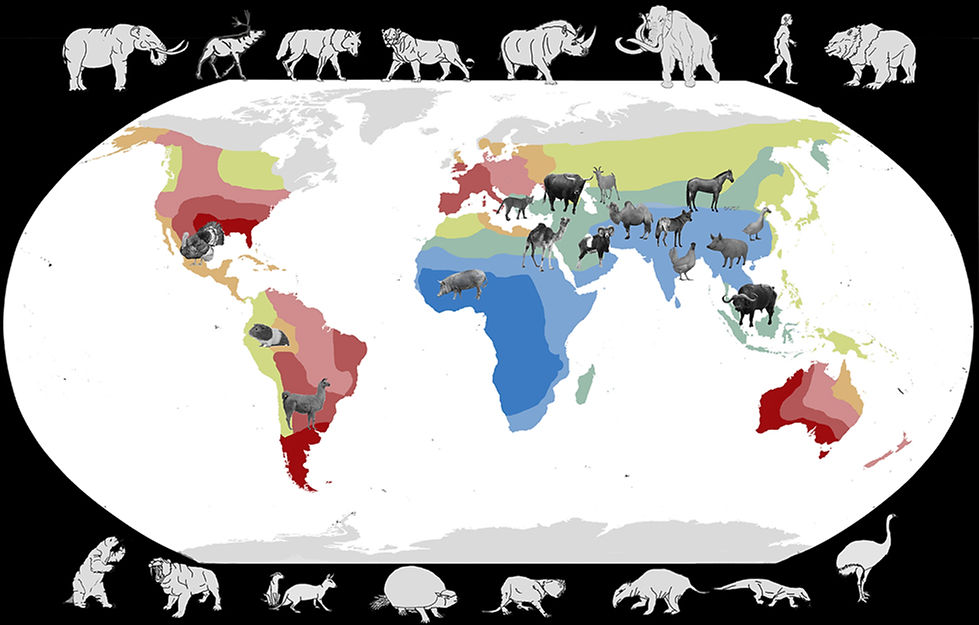10,000 years ago

Temple on the hill precedes the invention of agriculture
The Earth is emerging from the last ice age when temperatures had been about 7°C cooler and the northern latitudes frozen under ice sheets. Sea level is about 40 meters below what it is today. The Sahara is a grassland, and the Tigris and Euphrates valley a cradle of civilization. Large mammals in Asia and North America have already been driven to extinction by climate stress and hunting. Settled civilizations are emerging, some of which learn to manage their environments to support larger populations. (more)
Domestic animals in approximate locations of origin and a selection of animals that went extinct in Quaternary period.

Adapted from Christopher Sandom et al. Figure 1 map
High rates of extinction
Low rates of extinction
Measures

Population
8.2 billion
CO2 concentration
423 parts per million
Average Temperature
15.1° C
Sea Level from datum in 1900
in meters (note change in scale
265± ppm
CO2
13.7°C
Temp.
5 million ±
Population
Sea level
-18 meters
End of ice age; Sahara was grassland
Kingdom of Egypt consolidated
Stonehenge built
Golden Age of Greece
Years
The end of the last ice age
The first evidence of large-scale social organization appears in the construction of Göbekli Tepe, a neolithic stone temple on a hill overlooking the Fertile Crescent, starting about 9000BCE. Built before grain fields are planted or animals domesticated, archaeologists speculate that the upright piers of the temple arrayed in a circle reflect celestial geometry, anchoring hunting/gathering peoples under the heavens. Symbols and animal totems carved confidently into the limestone persist until the present, particularly In India’s Vedic tradition. The temple is built using flint tools, long before metals are forged or ceramic pottery fired, anticipating an agricultural society of settled villages, towns and cities. Wherever population concentrates, local forests are cut for fuel. In winter, fires from multiple hearths close together release sulfurous wood smoke that hangs over settlements as air pollution.
Rapid warming at the end of the ice age opens northern regions to southern animals and people. Before the ice melts, sea level is still low enough to expose the land bridge between Asia and North America, but the weather is warmer. The sudden shift in habitat from dry, cold plains to moist, temperate forests, reduces grasslands that large northern mammals depend on, and brings hunters. The advance of people everywhere coincides with extinction of large animals: mammals, birds, reptiles, anything edible. The same people, when settled, prosper only when they learn to limit hunting and preserve the herd.
At the timescale of tens of thousands of years, longer climatic cycles come into play. Between 9,000 and 6,000 years ago the Sahara desert is sahel, a rolling plain with lakes populated by herds of grazing animals as well as pastoral peoples whose drawings of themselves and the animals they knew are still legible on rock ledges now deep in the desert. The rains return on a roughly 20,000 year cycle driven by changes in Earth’s orbit.
References
Text: Schmidt, K. (2007). Göbekli Tepe, A Stone Age Sanctuary in South-eastern Anatolia. Munich, ArchaeNova Verlag.
deMenocal, P. B. and J. E. Tierney (2012) "Green Sahara: African Humid Periods Paced by Earth’s Orbit." Nature Education Knowledge 3(10):12 https://www.nature.com/scitable/knowledge/library/green-sahara-african-humid-periods-paced-by-82884405.
Image: Composite from images in Schmidt, Adobe Stock Images and https://phys.org/news/2014-12-mankind-ancient-lineages.html
Map: Sandom C, F. S., Sandel and S. J.-C. B (2014 ). "Global late Quaternary megafauna extinctions linked to humans, not climate change." Proceedings of the Royal Society B 281(20133254).
Faith, J. T., J. Rowan, A. Du and P. L. Koch (2018). "Plio-Pleistocene decline of African megaherbivores: No evidence for ancient hominin impacts." Science 362 (6417): 938–941.
Ecoclimax. (2018). "The Origin of Crops and Domestic Animals." Retrieved 22 September 2018, 2018, from http://www.ecoclimax.com/2015/07/the-origin-of-crops-and-domestic-animals.html.
CO2: Scripps Institution of Oceanography. (2018). "The Keeling Curve: Carbon dioxide concentration at Mauna Loa Observatory." Retrieved 20 September 2018, from https://scripps.ucsd.edu/programs/keelingcurve/wp-content/plugins/sio-bluemoon/graphs/co2_10k.png
Temperature: Marcott, Shaun A., Shakun, Jeremy D., Clark, Peter U. and Mix, A. C.(2013). "Temperature for the Past 11,300 Years." Science Vol. 339(6124): 1198-1201. http://doi.org/10.1126/science.1228026
Sea Level: Lambeck, K., Y. Yokoyama and T. Purcell (2002). "Into and out of the Last Glacial Maximum: sea-level change during
Oxygen Isotope Stages 3 and 2." Quaternary Science Reviews 21: 343-360. doi.org/10.1126/science.1059549
Population: Worldometers. (2018). "World Population by Year." Retrieved 20 September, 2018, from http://www.worldometers.info/world-population/world-population-by-year/.